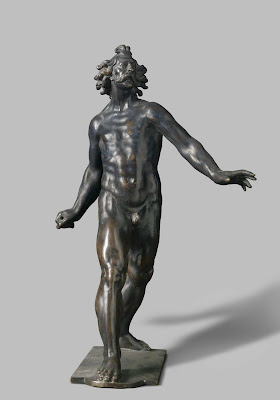 |
| Greece Akroterion from Grave Stele 4th century BC marble Hermitage, Saint Petersburg |
 |
| François Duquesnoy Rondanini Faun 1625-30 marble British Museum |
The statue above was very heavily restored in 1620s Rome by Flemish sculptor François Duquesnoy. It began with an ancient fragment of torso and one thigh. Duquesnoy added legs, arms, shoulders and head. Yet when the completed piece went on display in the Rondanini Palace in Rome it became famous as the Rondanini Faun, a prestigious Roman statue, not as a modern statue by the young artist François Duquesnoy, friend of Nicolas Poussin. Duquesnoy's involvement was no secret, but somehow his contribution was not considered conclusive. Even so, from the sculptor's point of view there was no essential distinction between an elaborate "restoration" (like that above) and a new, independent work of sculpture (like the ivory below) generated from raw materials, imagination and manual ability alone.
"In the seventeenth century the antique was valued, but not as a fragment. High prices were paid for ancient sculptures, and princes and cardinals would quarrel over finds, and farmers struggle to maintain their rights over territory under which such treasures might be found. . . . Broken and fragmentary marbles were avidly hunted, collected, and then, more often than not, kept in store-rooms; for in a sculpture gallery, on a staircase, in a loggia or in a garden, only complete statues were judged fit for display. And so developed the profession of the restorer, the man who converted the former into the latter. This was by far the steadiest and most reliable profession the sculptor could adopt."
– Jennifer Montagu, from Roman Baroque Sculpture: The Industry of Art (Yale University Press, 1989)
Jennifer Montagu reported in her 1989 text that the Rondanini Faun "having languished for decades in the store-rooms of the British Museum because so little of it met the criteria of the Department of Greek and Roman Antiquities, is now, by a most enlightened exchange, the centerpiece of the baroque primary gallery at the Victoria and Albert Museum." However, according to the current online catalog, the statue has returned to the British Museum, no longer in storage but on display – as 17th-century work by Duquesnoy.
 |
| attributed to François Duquesnoy Bound Christ 1620s ivory statuette National Gallery of Art, Washington DC |
 |
| Rome Head of Apollo 1st-2nd century AD marble British Museum |
 |
| attributed to Andrea del Verrocchio St Jerome before 1488 terracotta sketch-model Victoria & Albert Museum, London |
 |
| Andrea della Robbia Boy playing Bagpipes ca. 1490-1520 enameled terracotta statuette Victoria & Albert Museum, London |
 |
| Willem Danielsz van Tetrode Striding Warrior 1562-67 bronze statuette Rijksmuseum, Amsterdam |
 |
| Rome The Farnese Hermes 1st century AD marble British Museum |
"Marble statue of Hermes wearing small chlamys and winged sandals; caduceus in left hand; left hand and much of legs restored. The statue is a Roman copy of a famous type created in the school of the Greek sculptor Praxiteles in the fourth century BC. Together with a statue of Apollo, this sculpture once framed the central doorway of the gallery in the Palazzo Farnese in Rome."
Entered the British Museum in 1864. Purchased through agents from the hereditary owner, Ferdinand II King of Naples and Sicily.
– curatorial notes, British Museum
 |
| Anonymous Italian sculptor Copy of Medici Vase 17th century marble copy of frieze elements Hermitage, Saint Petersburg |
 |
| Anonymous Dutch sculptor Admiral Piet Hein ca. 1650 painted wood Rijksmuseum, Amsterdam |
 |
| Anonymous Dutch sculptor Stadholder Frederik Hendrik ca. 1625-75 painted wood Rijksmuseum, Amsterdam |
 |
| François Dieussart William II Prince of Orange ca. 1650-75 painted wood Rijksmuseum, Amsterdam |
 |
| Francesco di Valdambrino Virgin Annunciate ca. 1423 carved and painted walnut Rijksmuseum, Amsterdam |
 |
| Gianlorenzo Bernini Bust-portrait of Louis XIV 1665 marble (carved in Paris) Palace of Versailles |
 |
| François Dieussart Portrait of Charles II in exile ca. 1650 marble Rijksmuseum, Amsterdam |